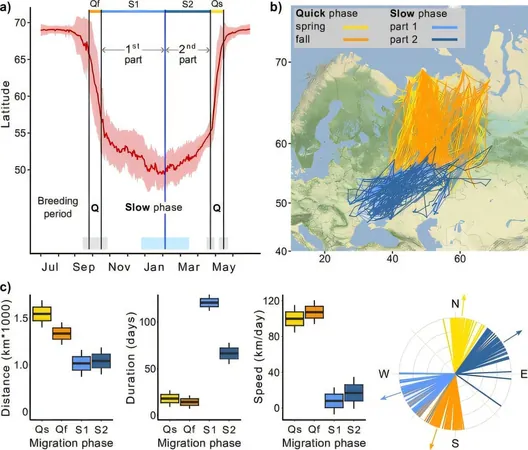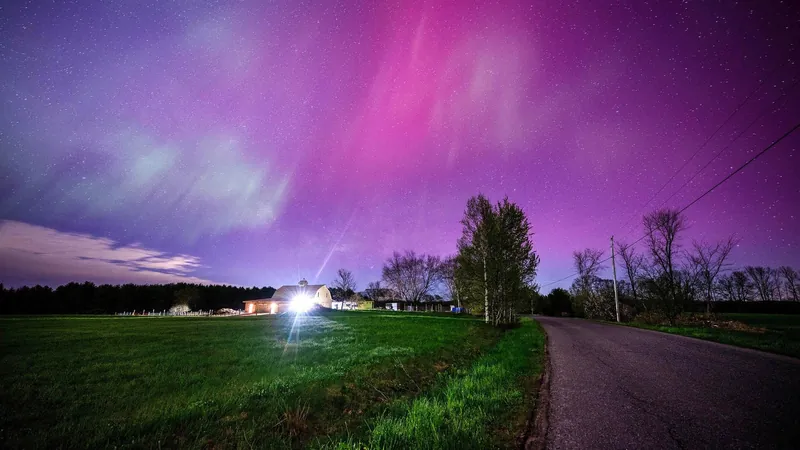
Groundbreaking Study Unveils New Migration Patterns of Arctic Raptors, Challenging Long-Held Beliefs!
2024-11-11
Author: Olivia
In a revolutionary finding, researchers from the Max Planck Institute of Animal Behavior have shaken the foundations of bird migration theories, revealing a new, dynamic migration pattern of Arctic-breeding raptors that could reshape conservation strategies. Traditionally, it has been believed that migratory birds return to their winter habitats and remain there until spring; however, the study of the rough-legged buzzard suggests otherwise.
The rough-legged buzzard, which inhabits the Arctic during the breeding season and migrates to mid-latitudes for the winter, showcases an extraordinary "foxtrot migration” pattern. This involves a rapid initial movement to mid-latitudes, followed by a more leisurely southwestward journey throughout the winter, before rapidly returning to the Arctic come mid-April. This revelation challenges the effectiveness of conventional mid-winter surveys, often used to define wintering ranges, such as the beloved Christmas Bird Counts.
Lead author Ivan Pokrovsky explains the implications of these findings: “What if regions that seem densely populated during winter are, in reality, transient hotspots? Understanding the actual migratory dynamics is crucial for accurately mapping winter ranges and protecting vulnerable species.
The study involved extensive tracking of the rough-legged buzzards over seven years using cutting-edge GPS technology. Remarkably, these birds cover about 1,500 kilometers in two weeks during their southward migration, but they don’t simply settle down. Instead, they gradually traverse an additional 1,000 kilometers at a slower pace, only to reverse the journey mid-winter with the same deliberate pace before speeding back to their Arctic breeding grounds.
While conducting mid-winter surveys, scientists found these raptors predominantly in the southwestern segments of their wintering range, mischaracterizing their habitat use. The opposite is true: the birds often spend significant time in the northeastern areas of their range for much of the winter. “To accurately map these migratory patterns, it's critical to track movements throughout the entire winter rather than relying on just mid-winter snapshots,” stresses Pokrovsky.
Additionally, this research has vital implications for understanding population dynamics. Suppose a decline in raptor numbers is observed in southern wintering areas. In that case, it might indicate a shift in movement patterns rather than a true decrease in the overall population. The researchers also highlighted how changes in snow cover related to climate change could influence these migration routes, signaling a pressing need for adaptive conservation strategies.
Senior author Martin Wikelski emphasizes the importance of this research. "By utilizing advanced tracking technologies, we can uncover vital information about species' behaviors and migration patterns, which are crucial in our efforts to conserve these raptors amid the modern challenges of climate change and environmental pressures."
As we navigate an era filled with unpredictable environmental changes, these findings could be pivotal, igniting new discussions regarding bird migration, conservation efforts, and the interconnectedness of wildlife and climate. The study is published in the esteemed journal *eLife*, calling for a reevaluation of how we think about and protect our migratory species.
Stay tuned as we continue to uncover more remarkable findings that challenge our understanding of the natural world!









 Brasil (PT)
Brasil (PT)
 Canada (EN)
Canada (EN)
 Chile (ES)
Chile (ES)
 España (ES)
España (ES)
 France (FR)
France (FR)
 Hong Kong (EN)
Hong Kong (EN)
 Italia (IT)
Italia (IT)
 日本 (JA)
日本 (JA)
 Magyarország (HU)
Magyarország (HU)
 Norge (NO)
Norge (NO)
 Polska (PL)
Polska (PL)
 Schweiz (DE)
Schweiz (DE)
 Singapore (EN)
Singapore (EN)
 Sverige (SV)
Sverige (SV)
 Suomi (FI)
Suomi (FI)
 Türkiye (TR)
Türkiye (TR)